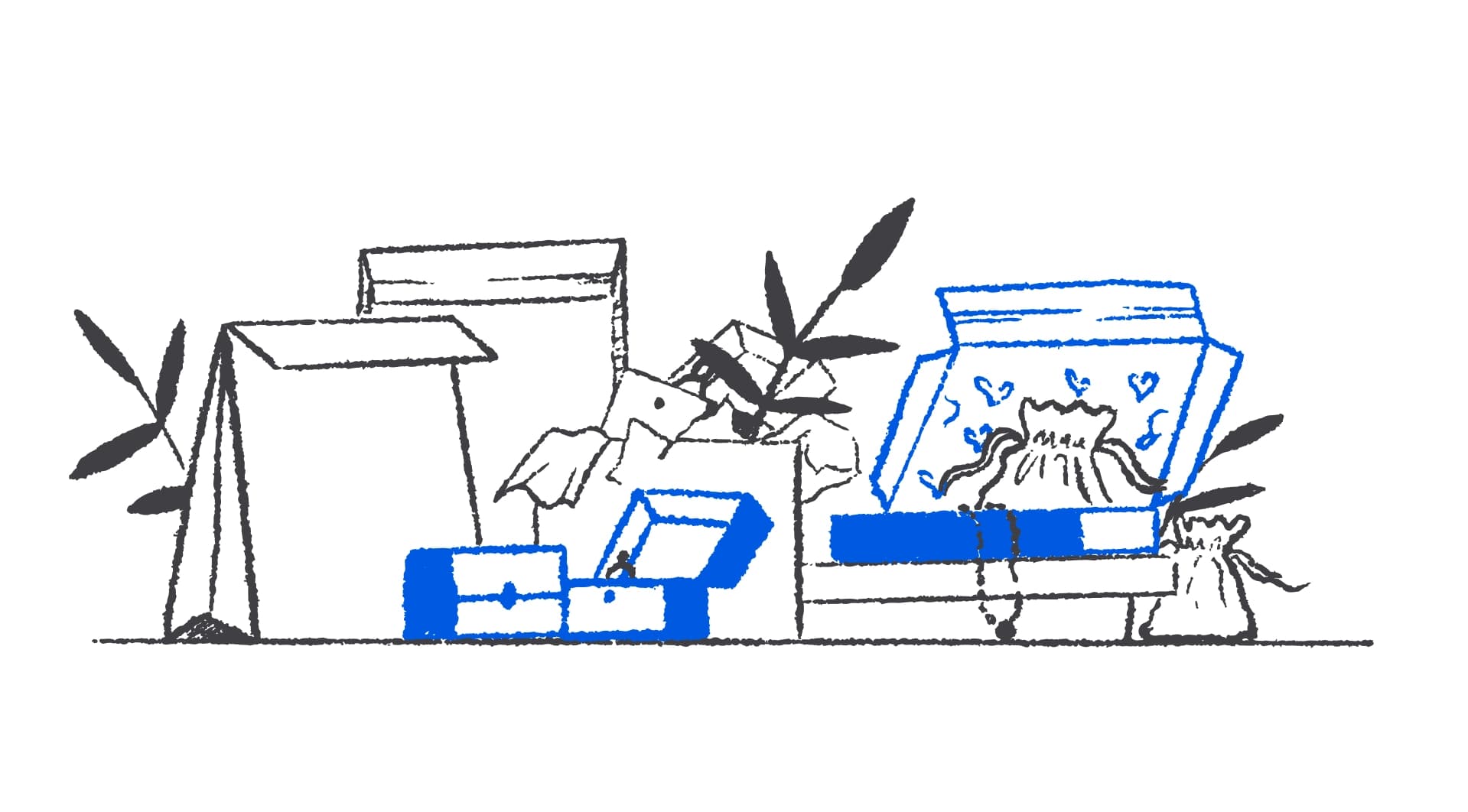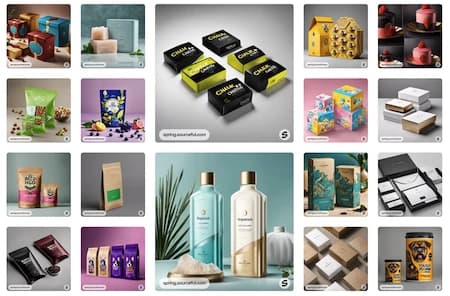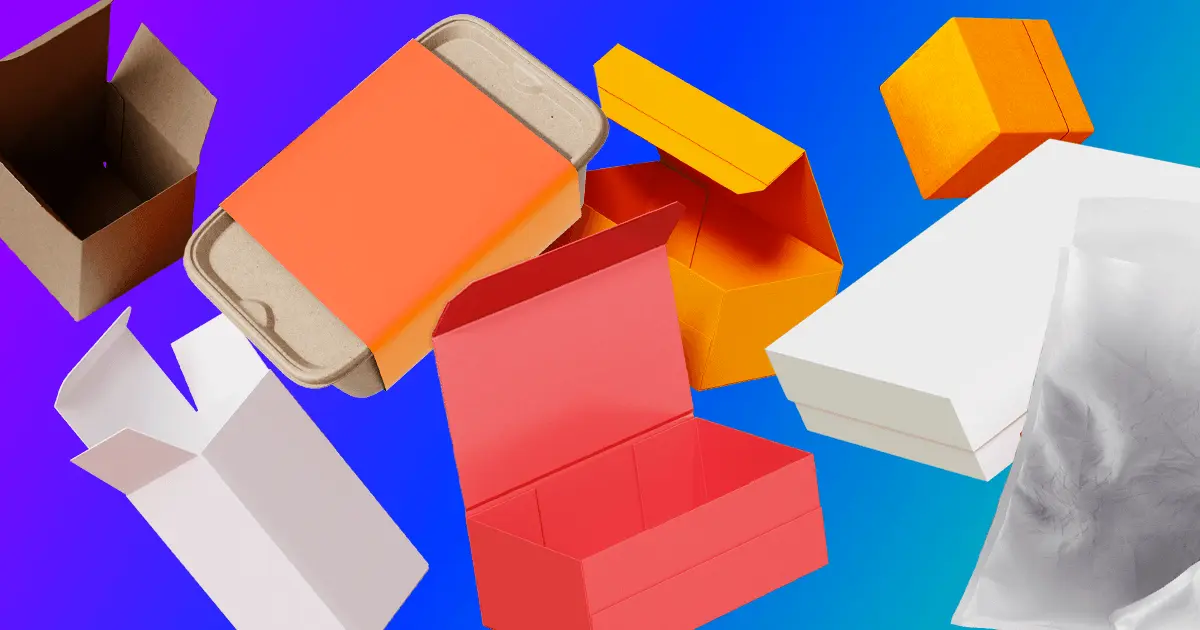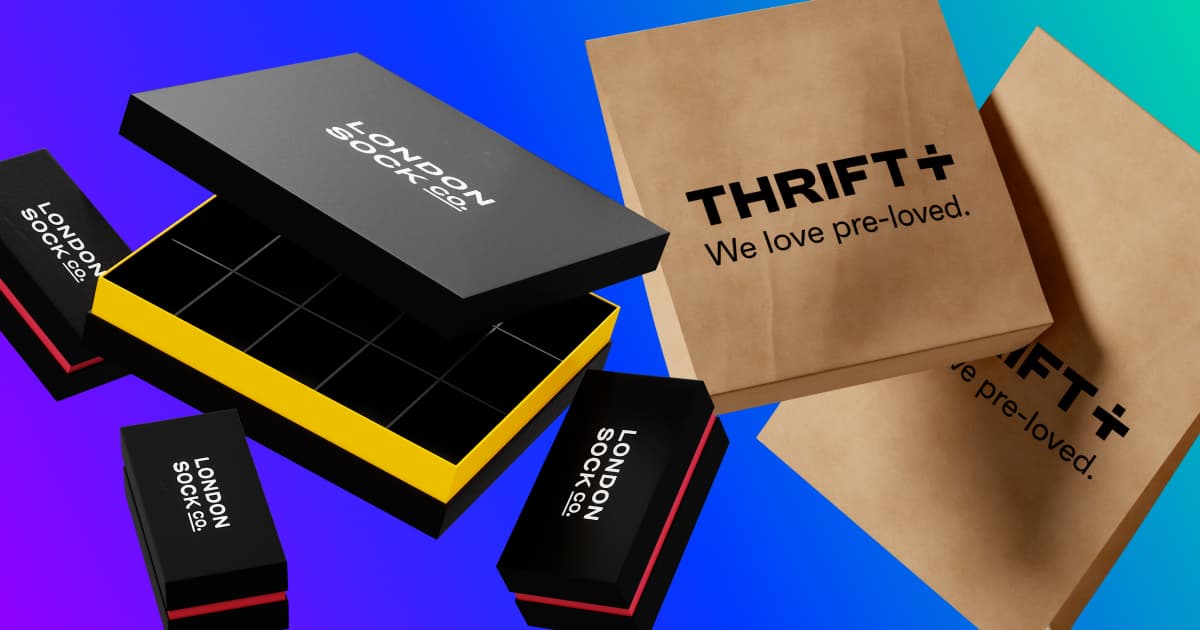Blog Post12 best sustainable jewellery packaging ideas for climate-conscious brands
- Sustainability
- Materials
- Design
- Innovation
Bryony CarragherMay 8, 2023 - 8 min read

When shopping for jewellery, customers are increasingly seeking brands with a strong sustainability agenda. But sustainability doesn’t stop at your product. In fact, the materials you choose to package your jewellery with also matter.
Here’s a list of 12 ideas to help you offer beautiful jewellery packaging whilst reducing your environmental impact.
More sustainable jewellery packaging ideas
- Paper
- Corrugated cardboard
- Cartonboard
- Recycled poly mailers
- Organic cotton
- Linen
- Bamboo
- Tissue paper wrapping
- Mono-materials
- Minimalism
- Embossing
- Reusability
1. Paper: best for lightweight protection
Paper has been used as a packaging material for centuries, and for good reason. It’s lightweight, versatile and customisable. Because of this, it’s easy to showcase your brand’s personality and values. This can help you attract and retain customers.
Paper is great for jewellery packaging in bags or envelopes. Like our paper mailer bags, which are a more sustainable alternative to plastic poly mailers. They can also be used as secondary packaging to protect your jewellery’s primary packaging (think boxes or fabric pouches) during transit. Or, for added protection, you can send your products in a honeycomb mailer bag, a neat (and more sustainable) replacement for bubble lined mailers.
Paper packaging is easily recycled at the kerbside and can be made into new paper-based products, which reduces waste and the need for virgin materials. And whilst trees are a renewable resource, not all forests are managed sustainably. So for the most sustainable approach, choose paper packaging that’s certified by the Forest Stewardship Council. This is an international organisation that promotes responsible management of the world's forests.
Both of our paper mailers are made with FSC-certified, natural kraft paper to help you reduce your environmental footprint.
Benefits of paper
- Versatile
- Recyclable
- Lightweight
- Cost-effective
- Customisable
Cons of paper
- Limited protection
- Limited barrier properties (moisture and air)
2. Corrugated cardboard: best for delicate items
Picture your customer receiving their jewellery in a beautifully designed box. What does that box look like? Maybe it’s black and sleek, oozing elegance. Or it’s charmingly fun and floral. With corrugated cardboard, the design possibilities really are endless.
Corrugated cardboard mailer boxes are a jewellery packaging staple. They’re so versatile that you can choose the exact dimensions you need, whether you’re packaging a necklace or earrings. You can then pair them with custom inserts, to keep your items neat and tangle-free ready for your customer to open.
You can also can print your own branding and artwork on corrugated cardboard. This will help drive brand recognition and create that special unboxing experience for your customer.
In terms of sustainability, corrugated cardboard is one of the most sustainable materials out there. For starters, you can choose the exact dimensions you need for your product so there's no wasted space. This stops you from shipping wasteful air in your packaging, which would otherwise increase your carbon emissions. Corrugated cardboard is also widely collected at the kerbside and easily recycled into new products. Seemingly small decisions like these can actually have a big impact on the sustainability of your jewellery packaging.
Benefits of corrugated cardboard packaging
- Durable
- Reusable
- Recyclable
- Lightweight
- Customisable
Cons of corrugated cardboard packaging
- Not moisture resistant
3. Cartonboard: best for branding
Have you ever seen a necklace or pair of earrings in a shop window, backed by a slim piece of card? That’s cartonboard. And it does a great job of keeping jewellery items visible with minimal packaging.
One major advantage of cartonboard is how easy it is to customise. You can create packaging in all shapes and sizes and print unique designs that appeal to your customers. You can use it to make boxes, sleeves, tags, and gift cards for special messages — all perfect for jewellery.
Our cartonboard products are FSC-certified and easily recycled, which can help you reduce your business’s environmental impact.
Benefits of cartonboard
- Versatile
- Recyclable
- Cost-effective
- Customisable
Cons of cartonboard
- Not moisture resistant
- Not as protective as corrugated cardboard
4. Recycled poly mailers: a direct swap for virgin poly mailers
We get it. Despite the ongoing plastic packaging crisis, sometimes you may need certain traits of plastic to protect your jewellery. For example, you may need a waterproof material. Or, you may simply want packaging that will conceal the contents, which would be true for more expensive pieces.
If this is the case, choose recycled plastic poly mailers. These are a more sustainable alternative to virgin poly mailers. They repurpose plastic waste, preventing it from entering landfills and oceans and are widely collected at the roadside for recycling.
Using one of our recycled mailer bags can help you reduce your carbon footprint by up to 30% compared to a virgin poly mailer. And improving your sustainability doesn’t mean sacrificing style. You can customise your mailer bag in all the usual ways (like printing artwork), so that it remains an extension of your brand.
Our mailer bags also contain at least 30% of recycled content, keeping you aligned with regulations and exempt from the Plastic Packaging Tax.
Benefits of recycled mailer bags
- Recycled materials
- Recyclable
- Affordable
- Lightweight
- Customisable
Cons of recycled mailer bags
- Don’t break down naturally
- Not protective against crushing
5. Organic cotton: best for stylish details
There’s something about fabric that adds flair to any gift. And cotton is no exception. Its soft, cushioning character protects from scuffs and scrapes during handling. This couldn’t be more important for jewellery which, with its delicate metals and stones, can be easily damaged during handling.
Cotton is a great choice for jewellery pouches, ribbons and void filling. It’s a more sustainable alternative to synthetic materials, like nylon. And you’ll probably be most familiar with cotton in its fabric form. But, did you know that unwanted cotton rags can be turned into a cotton pulp, which can then be hardened to create bespoke jewellery boxes? For jewellery brands looking to stand out, this could be attractive to climate-conscious customers.
Before choosing cotton over less sustainable alternatives like plastic, check that it’s been grown in the most responsible way possible. For example, cotton grown under Fairtrade Standards has been grown with fewer harmful chemicals. The farmers’ health, safety and salaries are protected and the Fair Trade organisation also helps them adapt to climatic changes.
Benefits of cotton
- Soft
- Natural
- Reusable
- Customisable
Cons of cotton
- Can be costly
- Not waterproof
- May require extra packaging for protection
6. Linen: best for a natural appearance
Linen, like cotton, can be used for ribbons and pouches. And it’s often celebrated among the climate-conscious for its natural, wrinkly appearance. Just like cotton, linen can add a decorative touch to your jewellery packaging, as well as protect your items from scratches during handling.
Linen fabric comes from the flax plant, a resilient crop which can be grown in poor soil conditions. This means it requires less water and fewer pesticides than some of our most popular crops like cotton. What’s more, every part of the flax plant can be used, from creating linseed oil to harvesting flax seeds for food. The fact that flax is so low maintenance and useful means it’s a great packaging material for brands that want that soft, natural appearance.
Benefits of linen
- Natural
- Reusable
- Customisable
- Premium feel
Cons of linen
- Not waterproof
- More costly than paper
- May require extra materials for protection
7. Bamboo: best for durable, reusable packaging
For packaging that gives off natural, rustic vibes, bamboo could be the material for you. It’s easily shaped and can be used to make reusable boxes, trays and stands. It’s also strong and sturdy, making it ideal for safely shipping and displaying jewellery.
Bamboo is known for its durability and unique texture. Not to mention its perception among customers as a more sustainable packaging material. And they’re right. Bamboo grows quickly and requires little water, so it's considered a renewable resource with a lower environmental impact than traditional plastic packaging.
Bamboo packaging’s striking appearance can really help you stand out as a brand with a strong sustainability agenda. But make sure you choose bamboo packaging that's certified by organisations such as the Forest Stewardship Council (FSC). This way, you’ll know that your bamboo has been grown and harvested in an environmentally and socially responsible way.
Benefits of bamboo
- Strong
- Durable
- Renewable
- Customisable
- Unique and natural texture
Cons of bamboo packaging
- Can be costly
- Limited availability
8. Tissue paper: best for void fills and unboxing experiences
Simple yet effective, tissue paper is an excellent jewellery packaging choice for brands seeking lightweight and budget-friendly wrapping. It’s a thin, translucent paper that’s fully customisable and easy to handle. As a wrapping material, it offers soft, cushioning protection against scrapes. But it can also be used as interior packaging to fill voids and add a colourful and stylish touch to the unboxing experience.
From a sustainability viewpoint, tissue paper can be made from recycled materials and is also recyclable after use.
Benefits of tissue
- Low cost
- Attractive
- Recyclable
- Lightweight
- Customisable
Cons of tissue
- Not durable
- Limited protection
Approaches to more sustainable jewellery packaging
Choosing the most sustainable materials for your jewellery packaging is key to reducing your environmental impact. But it doesn’t stop there.
Here are four design and manufacturing approaches that you can take to reduce your impact even further.
9. Mono-material packaging
“Mono” means “one.” So, mono-material packaging is made from just one material. This can be a more sustainable alternative to multi-material packaging for two reasons.
First, your customers don't need to worry about separating materials before disposing of your packaging. It's easy and straightforward. Second, as it can be hard for waste treatment centres to separate packaging with multiple layers, mono-material packaging is much easier to recycle and has a lower chance of ending up in landfill.
Benefits of mono-material packaging
- Cost-effective
- Reduces waste
- Easier to recycle
Cons of mono-material packaging
- Extra steps needed to ensure protection (e.g. thicker walls, coatings)
10. Minimalism
Minimalist packaging design embraces simplicity and functionality. This is where you use fewer materials (reducing waste) whilst protecting and displaying your jewellery. It’s a common sight in retail jewellery stores, with necklaces, bracelets and earrings attached to a thin piece of cardstock and then suspended on a rack.
Cardstock isn’t the only way to embrace minimalism. It can be as simple as reducing your packaging size. This means you end up using fewer materials and reducing packaging voids, making your packaging more efficient.
And less packaging doesn’t mean a missed branding opportunity. High street jewellery retailers like Accessorize do this brilliantly. You’ll see jewellery displayed on stylish cardstock with a tasteful logo. Proof that a simple design can be just as eye-catching as a more elaborate one and may even help your products appear more luxury.
Benefits of minimalism
- Stylish
- Cost-effective
- Reduces waste
Cons of minimalism
- Creativity needed to stand out from competition
11. Embossing
We’ve all picked up an embossed product and absentmindedly ran our fingers over it. This printing technique creates a raised design on your packaging, adding an attractive tactile element. It’s also an impressive sight, creating a high-end, luxury feel.
Embossing can reduce your need for additional materials, such as stickers, labels and inks used in printing.
Benefits of embossing
- Unique
- Stylish
- Permanent
Cons of embossing
- Limited design options
- Intricate designs may be hard to see
12. Reusability
It’s happened to most of us. Opening that Quality Street tin only to find it stuffed with sewing supplies. Now, Nestlé probably didn’t design their chocolate packaging to store needles and thread. Or, maybe they did and it's a clever marketing ploy. All we know is that it’s a perfect example of packaging that can be used again and again. And how you can keep your brand in your customer’s mind for months, even years after purchase.
Reusable packaging helps brands reduce their waste. But it also means providing something that customers can use for other purposes, such as boxes or bags. This includes that rustic bamboo box or stylish fabric pouches we mentioned earlier. You could also offer drawer-style packaging, which customers can store your jewellery in for years to come.
Benefits of reusable packaging
- Reduces waste
- Generates brand awareness
- Reduces single-use packaging
Cons of reusable packaging
- May be more expensive to design than single-use options
How to choose the best sustainable jewellery packaging for your business
1. Figure out your product’s protection needs
When switching to more sustainable jewellery packaging, the first step is to consider the level of protection you need. This will depend on the materials and fragility of your product. For example, you may need packaging that provides extra padding, as with glass or metal items that may scratch easily.
Getting your jewellery to your customers in perfect condition is crucial. So it’s important that you strike that balance between protection and sustainability.
2. Decide what you want your packaging to say
Your packaging carries your brand’s personality and values into the hands of the customer, so it’s important to get its design right. This will help you increase and maintain brand awareness and loyalty.
You might find, for example, that your customers appreciate the raw, unprocessed simplicity of natural kraft paper packaging. This would help you appeal to a more climate-conscious demographic. Or, you might ditch excess materials in favour of a more sophisticated, minimalist look.
As an extension of your brand, your packaging can be powerful in differentiating you from your competitors. So, when designing, think about the impression you want to leave your customers with.
3. Design for recycling or reuse
Ideally, your jewellery packaging should be reusable or recyclable. This way, it can have an extended life in your customers’ homes or be turned into new products. For example, paper and cardboard are amongst the easiest materials to recycle because they’re collected at most kerbsides. And they don’t need intensive heating or energy to be turned into new products.
To take the pressure to recycle away from customers, some companies, like Boots, are offering a take-back scheme. They encourage customers to drop off any plastic packaging to a Boots store and sometimes reward them with loyalty points. Boots then sends the packaging to a processing company that turns even the hardest-to-recycle materials into new products.
Discover more sustainable packaging with Sourceful
Whether packaged in lightweight tissue wrapping or sturdy corrugated cardboard boxes, your jewellery needs to get to your customer scratch and tamper-free. And your jewellery packaging design can be as impactful as the product itself. One that signals your brand values whilst maintaining a lower environmental impact can leave a lasting impression on your customers and even increase loyalty to your brand.
For mailer boxes, cards and a whole host of more sustainable packaging to perfectly package your jewellery, browse our shop.








